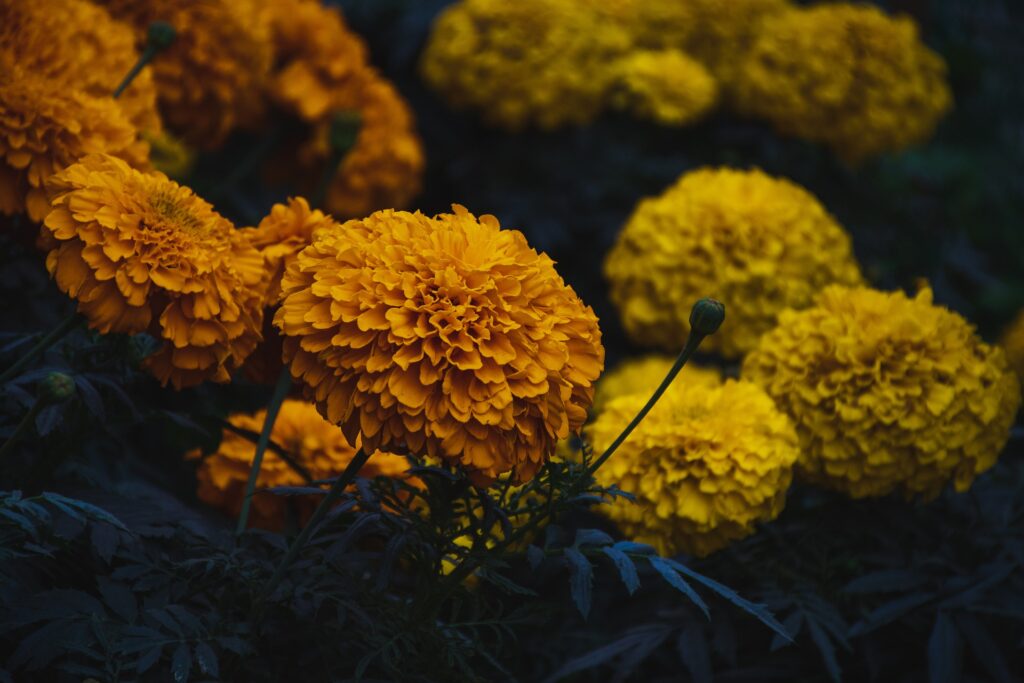Marigolds are a popular choice for gardeners due to their vibrant colors and ease of care. These cheerful flowers can brighten up any garden and provide continuous blooms throughout the growing season. Here’s a comprehensive guide on growing and caring for marigolds.

Types of Marigolds
Marigolds come in several varieties, each with unique characteristics. Here are some common types:
| Type of Marigold | Characteristics |
|---|---|
| African Marigolds | Large, pom-pom-like blooms, tall plants, perfect for garden borders and beds. |
| French Marigolds | Smaller, bushy plants with single or double blooms, ideal for edging and containers. |
| Signet Marigolds | Delicate, fern-like foliage with small, edible flowers, great for herb gardens. |
| Triploid Marigolds | Hybrid variety, vigorous growth, and large, colorful blooms. |
Growing Season
Marigolds bloom from late spring until the first frost, providing continuous color throughout the growing season.
| Season | Activity |
|---|---|
| Spring | Plant marigold seeds or transplants after the last frost. |
| Summer | Regular watering, deadhead spent blooms, and watch for pests. |
| Fall | Continue to deadhead and water until the first frost. |
| Winter | Minimal maintenance, clean up garden beds and prepare for next season. |
Sunlight and Water Needs
Marigolds thrive in full sun, requiring at least 6-8 hours of direct sunlight daily. They prefer moderately moist soil but are drought-tolerant once established. Water deeply once or twice a week, depending on weather conditions.
Soil Preferences
Marigolds prefer well-drained, moderately fertile soil with a slightly acidic to neutral pH.
| Soil Type | pH Level | Characteristics |
|---|---|---|
| Clay Soil | 6.0-7.0 | Retains moisture well but ensure good drainage. |
| Sandy Soil | 6.0-7.0 | Drains quickly, may need more organic matter. |
| Loamy Soil | 6.0-7.0 | Ideal for most plants, well-draining and nutrient-rich. |
Fertilization and Nutrients
Marigolds are not heavy feeders but benefit from occasional feeding. Use a balanced fertilizer during the growing season to promote healthy growth and abundant blooms.
| Season | Fertilization Type |
|---|---|
| Spring | Balanced NPK fertilizer (10-10-10) when planting. |
| Summer | Light feeding with balanced fertilizer if growth is slow. |
| Fall | No fertilization needed, prepare for winter. |
Pruning and Maintenance
Regular maintenance helps keep marigolds healthy and blooming. Deadhead spent flowers to encourage more blooms and prevent the plants from becoming leggy.
Additional Tips for Growing Marigolds
- Mulching: Apply a layer of mulch around the base of your marigolds to retain moisture and suppress weeds.
- Pest Control: Marigolds are known for their pest-repellent properties, but keep an eye out for aphids and spider mites. Use organic or chemical treatments as necessary.
- Winter Protection: Marigolds are annuals, so they will die back after the first frost. Collect seeds from mature flowers for planting next season.
Conclusion
Marigolds are a wonderful addition to any garden, offering bright, continuous blooms with minimal care. By selecting the right types, providing proper sunlight, water, and soil conditions, and following basic care guidelines, you can enjoy a vibrant display of marigolds all season long.